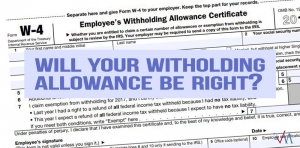Blog - Tax Related
Will Your 2018 Withholding Be Right?
Article Highlights:
|
|
Note: The is one of a series of articles explaining how the various tax changes made by the GOP's Tax Cuts & Jobs Act (referred to as the "Act" in the article), passed late in December 2017, might affect you and your family in 2018 and future years, and offering strategies you might employ to reduce your tax liability under the new tax laws.
One of the first trouble spots of the new tax reform is the W-2 withholding for 2018. Passage of the new law in late December hasn't given the IRS much time to develop new withholding tables. This can be a big issue, as the recent Tax Cuts & Jobs Act (TCJA) substantially altered the tax rates and standard deductions, did away with exemption deductions, and increased the child tax credits—all elements of how the withholding allowances and tables have been structured in the past.
On January 11, the IRS released modified withholding tables for employers to use for determining employee withholding. Supposedly the new withholding tables have been crafted to use the information employers already have from employees' prior Form W-4s on file to adjust their employees' withholding, taking into account the tax cuts for individuals included in the TCJA.
The IRS is also working on revising the Form W-4 to reflect additional modifications in the new law, such as changes in available itemized deductions, increases in the child tax credit, the new dependent credit and repeal of the dependent exemptions deduction.
When available, the new Form W-4 can be used by employees who wish to update their withholding in response to the new law or changes in their personal circumstances in 2018 and by workers starting a new job. Until a new Form W-4 is issued, employees and employers should continue to use the 2017 Form W-4.
You are cautioned to keep an eye on your take-home pay to ensure your withholding has not changed too drastically once your employer starts using the new IRS tables. Most wage earners should see a decrease in withholding (and a larger net paycheck), but if the change is too radical you could end up owing tax next year when you file your 2018 return.
If you are self-employed and/or have other sources of taxable income in addition to wages, or if you itemize your deductions, the wage withholding by your employer-based upon your existing Form W-4 probably will not provide the correct withholding, and you may need to make adjustments to your withholding allowances or even make estimated tax payments.
As 2018 is the first year that the vast majority of the provisions of TCJA will apply, you should be cautious that your withholding is not too little, resulting in a tax due next filing season, or too high, denying you the benefits of the tax cut until you receive your refund next year.
Please call this office if you need assistance in determining your withholding or if you have questions about the new tax law.
2018 Standard Mileage Rates Announced
Article Highlights:
As it does every year, the Internal Revenue Service recently announced the inflation-adjusted 2018 optional standard mileage rates used to calculate the deductible costs of operating an automobile for business, charitable or medical purposes.
|
|
Beginning on Jan. 1, 2018, the standard mileage rates for the use of a car (or a van, pickup or panel truck) are:
|
|
The business standard mileage rate is based on an annual study of the fixed and variable costs of operating an automobile. The rate for medical purposes is based on the variable costs as determined by the same study. The rate for using an automobile while performing services for a charitable organization is statutorily set (it can only be changed by Congressional action) and has been 14 cents per mile for over 15 years.
Important Consideration: The 2018 rates are based on 2017 fuel costs. Based on the potential for substantially higher gas prices in 2018, it may be appropriate to consider switching to the actual expense method for 2018, or at least keeping track of the actual expenses, including fuel costs, repairs, maintenance, etc., so that the option is available for 2018.
Taxpayers always have the option of calculating the actual costs of using their vehicle for business rather than using the standard mileage rates. In addition to the potential for higher fuel prices, the extension and expansion of the bonus depreciation as well as increased depreciation limitations for passenger autos in the Tax Cuts and Jobs Act may make using the actual expense method worthwhile during the first year a vehicle is placed in business service. However, the standard mileage rates cannot be used if you have used the actual method (using Sec. 179, bonus depreciation and/or MACRS depreciation) in previous years. This rule is applied on a vehicle-by-vehicle basis. In addition, the business standard mileage rate cannot be used for any vehicle used for hire or for more than four vehicles simultaneously.
Employer Reimbursement – When employers reimburse employees for business-related car expenses using the standard mileage allowance method for each substantiated employment-connected business mile, the reimbursement is tax-free if the employee substantiates to the employer the time, place, mileage and purpose of employment-connected business travel.
The Tax Cuts and Jobs Act eliminated employee business expenses as an itemized deduction, effective for 2018 through 2025. Therefore, employees may no longer take a deduction on their federal returns for unreimbursed employment-related use of their autos, light trucks or vans.
Faster Write-Offs for Heavy Sport Utility Vehicles (SUVs) – Many of today's SUVs weigh more than 6,000 pounds and are therefore not subject to the limit rules on luxury auto depreciation; taxpayers with these vehicles can utilize both the Section 179 expense deduction (up to a maximum of $25,000) and the bonus depreciation (the Section 179 deduction must be applied before the bonus depreciation) to produce a sizable first-year tax deduction. However, the vehicle cannot exceed a gross unloaded vehicle weight of 14,000 pounds. Caution: Business autos are 5-year class life property. If the taxpayer subsequently disposes of the vehicle before the end of the 5-year period, as many do, a portion of the Section 179 expense deduction will be recaptured and must be added back to your income (SE income for self-employed individuals). The future ramifications of deducting all or a significant portion of the vehicle's cost using Section 179 should be considered.
If you have questions related to the best methods of deducting the business use of your vehicle or the documentation required, please give this office a call.
Search
Categories
Recent Posts
-
23 Jan, 202322 Questions About 2022 Taxes
-
23 Jan, 2023Tax Updates for 2022
-
15 Dec, 2021Medical Expense Deductions
-
06 Oct, 2021The IRS Crackdown on Venmo, Zelle Payments
About Us
Mendoza & Company, Inc. is a full-service accounting, Payroll, and Tax Resolution firm in Bethesda, MD and Miami, FL. As a client, you gain a professional team with expertise in multiple fields, providing you the right advice to strengthens your organization and long-term goals.







